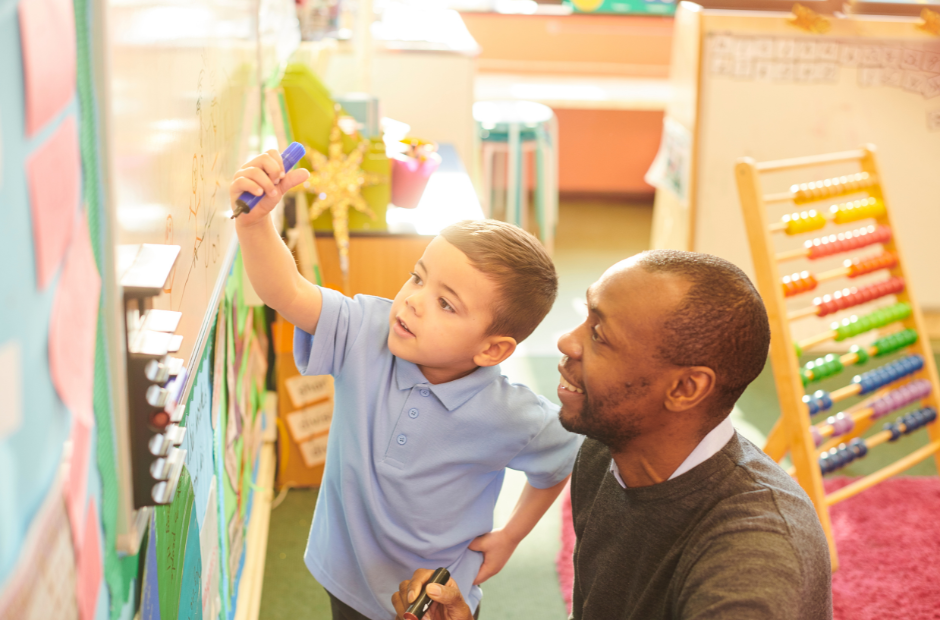Today, interactive whiteboards are essential in the classroom. They provide unique features that facilitate a higher level of student collaboration, engagement, and creativity that traditional whiteboards do not.
Also called smartboards, interactive whiteboards were especially useful during the height of the COVID-19 pandemic. As schools shut down, teachers relied on this educational technology to instruct students learning from home. But long before the pandemic, schools and governments invested in interactive whiteboards to enhance and supplement in-person learning.
In this article, we highlight seven highly effective uses for interactive whiteboards in the classroom. These uses benefit both students and teachers.
First, What Is a Smartboard?
Interactive whiteboards are large digital screens that implement touchscreen technology. They have many of the same uses as traditional whiteboards and include added features that facilitate collaboration, object manipulation, and engagement. For example, students can use their hands or a stylus to move objects around on a screen without erasing.
7 Highly Effective Interactive Whiteboard Uses in the Classroom
1. Foster Collaboration
Interactive whiteboards are the future of collaboration. For in-person classes, the smartboard’s large display allows multiple students to work on the same content simultaneously. Smartboards also remove the barrier between on-site and remote students in the same class. Remote learners can work with their in-person classmates simply by connecting their own device to the interactive whiteboard.
2. Increase Motivation
Every teacher faces the challenge of that one student who shows little-to-no interest in the course material. An interactive whiteboard introduces fun to the classroom environment and reduces boredom, as it did for this school district in South Carolina.
Smartboard interactive features may also help students feel like they’re a more integral part of the classroom experience. Students may also feel a better sense of direction within the classroom as they manipulate touch screens. Both factors can motivate students to participate more in their classes.
3. Boost Student Engagement
A research study from the Institute of Education Sciences demonstrated that interactive whiteboards increased student engagement. Smartboards boost student participation in class assignments, interaction with their classmates, and contribution to class discussions.
This type of active learning (instead of passive learning) is what many teachers aim for during their classes. Now, instructors across the United States and beyond are turning to interactive whiteboards to engage students on a higher level.
Interested in adding an interactive whiteboard to your classroom?
Gray & Creech Office Solutions provides smartboards, plus easy installation.
Call us today for your FREE consultation!
4. Allow Live Notetaking
Interactive whiteboards are ideal for students working on group projects, as they remove the need for students to share their notes individually. The Sharp Aquos BoardÒ allows up to 20 students to make notes on the smartboard at the same time. Students can then instantly save, share, and upload their notes with the entire class.
5. Engage Remote Learners
One primary interactive whiteboard use is for remote learning. As mentioned above, smartboards allow remote learners to watch class presentations on their own device. In addition, they can also add notes and contribute to presentations being displayed in the classroom. This type of connectivity ensures all students get involved, whether they’re learning on-site or remotely.
6. Create Better Presentations
Interactive whiteboards make dull presentations a thing of the past. Students and teachers can give more entertaining lectures and class presentations with Sharp’s Aquos Board. The interactive whiteboard’s advanced technologies enhance presentations with features like touch and drop, colored pen tools, and integrated speakers. These same features can give students more confidence during their presentations.
7. Accommodate All Students
Not all students learn the same, so it’s important to teach students according to their learning style. Students who prefer hands-on learning and manipulation may prefer the tactile features of interactive whiteboards. These students may enjoy using their hands to learn, instead of watching instruction from their seats. If you want to keep all of your students active during class, try introducing an interactive whiteboard.
Experience the Power of a Smartboard
Smartboards will continue to be a sought-after educational tool for the classroom. Gray & Creech Office Solutions can help select and install the right interactive whiteboard in your class. We offer the Sharp Aquos Board, a cost-effective smartboard with 20-point, multi-touch functionality, ultra-precise graphics, and plug-and-play connectivity.


